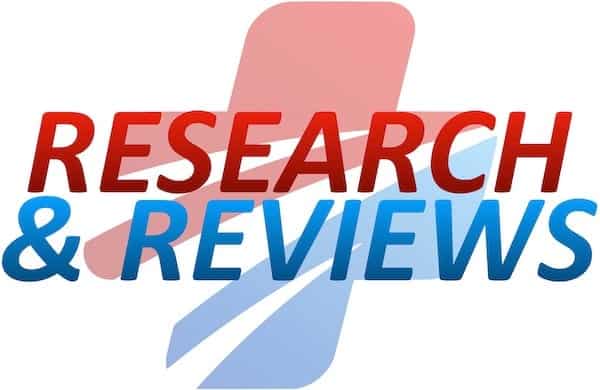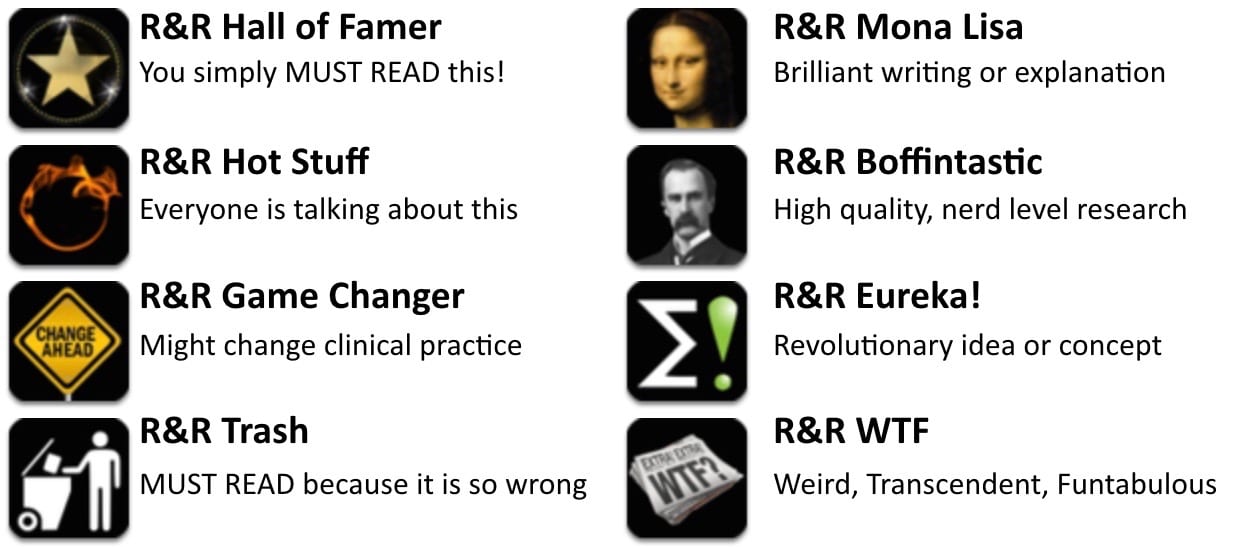R&R In The FASTLANE 028
Welcome to the 28th edition of Research and Reviews in the Fastlane. R&R in the Fastlane is a free resource that harnesses the power of social media to allow some of the best and brightest emergency medicine and critical care clinicians from all over the world tell us what they think is worth reading from the published literature.
This edition contains 9 recommended reads. The R&R Editorial Team includes Jeremy Fried, Nudrat Rashid, Soren Rudolph, Anand Swaminathan and, of course, Chris Nickson. Find more R&R in the Fastlane reviews in the : Overview; Archives and Contributors
This Edition’s R&R Hall of Famer
Russo SG, Cremer S, Eich C, Jipp M, Cohnen J, Strack M, Quintel M, Mohr A. Magnetic resonance imaging study of the in vivo position of the extraglottic airway devices i-gel™ and LMA-Supreme™ in anaesthetized human volunteers. Br J Anaesth. 2012 Sep 25. [Epub ahead of print] PubMed PMID: 23015619
- An anatomical MRI study on healthy volunteers with an LMA supreme and an i-gel placed. Not looking at quite the same question that the famous “Segal, compressed carotids” study looked at but still it’s more info on what happens in that dark pharynx when you plunge one of those supra-glottic airways in.
- Recommended by: Andy Neill
- Learn more: EM Ireland EMI
Hossain-Ibrahim MK, Tarnaris A, Wasserberg J. Decompressive craniectomy – friend or foe? Trauma. 2012 Jan vol. 14 no. 1 16-38 [abstract]
- To cut a big hole in the skull vault or not for refractory elevation of ICP? The small centre retrospectives say yes. DECRA for TBI says you”ll exchange mortality for poor function. For malignant MCA, there may be benefit if performed for the right patient within 48 hours of the initial insult; but therein lies the difficulty. There’s equipoise and uncertainty everywhere, with no level I evidence based guidelines. RescueICP is awaited, but will it provide the answers?<
- Recommended by: Matthew Mac Partlin
Myburgh JA, Finfer S, Bellomo R, Billot L, Cass A, Gattas D, Glass P, Lipman J, Liu B, McArthur C, McGuinness S, Rajbhandari D, Taylor CB, Webb SA; the CHEST Investigators and the Australian and New Zealand Intensive Care Society Clinical Trials Group. Hydroxyethyl Starch or Saline for Fluid Resuscitation in Intensive Care. N Engl J Med. 2012 Oct 17. [Epub ahead of print] PubMed PMID: 23075127 – [Fulltext]
- Another nail in the starch coffin.
- Recommended by: Cliff Reid, Chris Nickson
- Learn more: Resus.ME, ICN
Patrick SP, Tijunelis MA, Johnson S, Herbert ME. Supraclavicular subclavian vein catheterization: the forgotten central line. West J Emerg Med. 2009 May;10(2):110-4. PubMed PMID: 19561831; PubMed Central PMCID: PMC2691520
- Remember the supraclavicular approach to subclavian access is an option – especially in children. Here is how.
- Recommended by: Thomas Dolven
- Learn more: ScanCrit
Serpa Neto A, Cardoso SO, Manetta JA, Pereira VG, Espósito DC, Pasqualucci Mde O, Damasceno MC, Schultz MJ. Association between use of lung-protective ventilation with lower tidal volumes and clinical outcomes among patients without acute respiratory distress syndrome: a meta-analysis. JAMA. 2012 Oct 24;308(16):1651-9. doi: 10.1001/jama.2012.13730. PubMed PMID: 23093163.
- A meta-analysis corroborates what many of us believe – that a lung protective strategy to ventilation is a good thing for patient who don’t have ARDS (yet) as well as those that do.
- Recommended by: Cliff Reid, Chris Nickson
- Learn more — Resus.ME
Johnson-Coyle L, Jensen L, Sobey A; American College of Cardiology Foundation; American Heart Association. Peripartum cardiomyopathy: review and practice guidelines. Am J Crit Care. 2012 Mar;21(2):89-98. doi: 10.4037/ajcc2012163. Review. Erratum in: Am J Crit Care. 2012 May;21(3):155. Dosage error in article text. PubMed PMID: 22381985.
- Concise review on current understanding and care for peripartum acute cardiomyopathy. Rare, but important morbidity and mortality implications, including for future pregnancy. Good tables for diagnosis and treatment, but little high quality evidence so largely consensus recommendations.
- Recommended by: Matthew Mac Partlin
Yu JS, Cody ME. A template approach for detecting fractures in adults sustaining low-energy ankle trauma. Emerg Radiol. 2009 Jul;16(4):309-18. Epub 2009 Feb 18. Pubmed PMID: 19224258<
- A great paper on how to systematically review an ankle x-ray and where the money is in looking for fractures. Some nice stuff on mechanism of injury too.
- Recommended by: Andy Neill
Roberts BW, Kilgannon JH, Mitchell JA, Mittal N, Aji J, Kirchhoff ME, Zanotti S, Parrillo JE, Chansky ME, Trzeciak S. Emergency Department inter-hospital transfer for post-cardiac arrest care: Initial experience with implementation of a regional cardiac resuscitation center in the United States. Resuscitation. 2012 Sep 20. pii: S0300-9572(12)00807-6. doi: 10.1016/j.resuscitation.2012.09.018. [Epub ahead of print] PubMed PMID: 23000361.
- Our American chums have recommended cardiac resuscitation centres for the survivors of cardiac arrest. There’s not much data out there at the moment but this study from the US (although very small) makes interesting reading. It really chimes with Scott Weingart’s interview with Cliff Reid about a recent out of hospital cardiac arrest in a 45 year old man. If you heard that then you might want to read this too.
- Recommended by: Simon Carley
Ker K, Edwards P, Perel P, Shakur H, Roberts I. Effect of tranexamic acid on surgical bleeding: systematic review and cumulative meta-analysis. BMJ. 2012 May 17;344:e3054. doi: 10.1136/bmj.e3054. Review. PubMed PMID: 22611164; PubMed Central PMCID: PMC3356857.
- In this subanalysis of the CRASH-2 data it looks like there is roughly a 30% reduction in mortality across all severity of injury. They have looked at the effectiveness of TXA at different levels of predicted mortality. The beneficial effect of TXA seems to be consistent at all levels. So, give the TXA chaps (and ladies)
- Recommended by: Simon Carley
Pitts SR, Pines JM, Handrigan MT, Kellermann AL. National Trends in Emergency Department Occupancy, 2001 to 2008: Effect of Inpatient Admissions Versus Emergency Department Practice Intensity. Ann Emerg Med. 2012 Jun 20. [Epub ahead of print] PubMed PMID: 22727201.
- Big NHAMCS analysis of ED occupancy (as a proxy for crowding). While they show boarding does contribute to increased occupancy rates, one of the big drivers was increased testing in the ED (although some of that may decrease admissions?)
- Recommended by: Seth Trueger
Chris is an Intensivist and ECMO specialist at The Alfred ICU, where he is Deputy Director (Education). He is a Clinical Adjunct Associate Professor at Monash University, the Lead for the Clinician Educator Incubator programme, and a CICM First Part Examiner.
He is an internationally recognised Clinician Educator with a passion for helping clinicians learn and for improving the clinical performance of individuals and collectives. He was one of the founders of the FOAM movement (Free Open-Access Medical education) has been recognised for his contributions to education with awards from ANZICS, ANZAHPE, and ACEM.
His one great achievement is being the father of three amazing children.
On Bluesky, he is @precordialthump.bsky.social and on the site that Elon has screwed up, he is @precordialthump.
| INTENSIVE | RAGE | Resuscitology | SMACC








